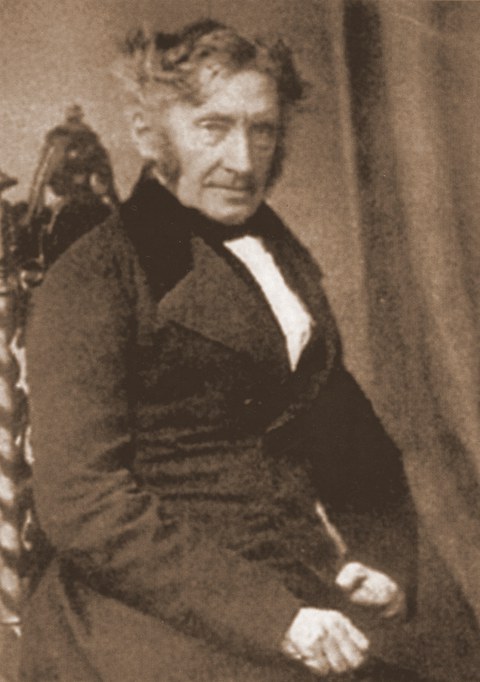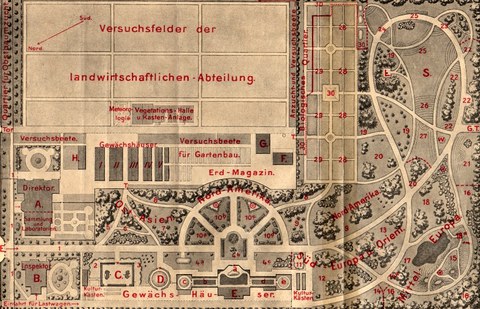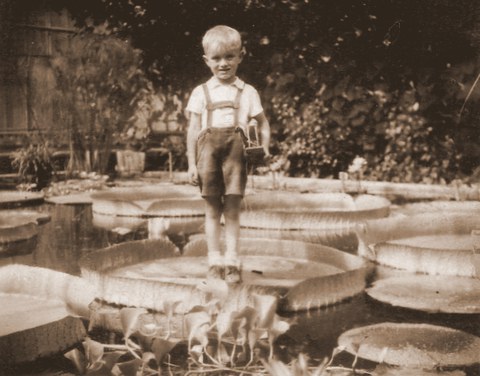History
The history of the Botanical Garden in Dresden is just as eventful as the history of Dresden itself. It begins in the year 1815, when a plot of land for the creation of a botanical garden was assigned to the former Surgical Medical Academy. It was on the eastern edge of the old city, not where the Botanical Garden is today. The facility was completed in 1820. The first Director was Professor of Natural History Heinrich Gottlieb Ludwig Reichenbach (1793-1879). He was a remarkable man: one of the most important scientists of his time. At the same time, he was director of the Natural History Museum and also one of the co-founders of the Zoo and of the Dresden Animal Welfare Society. His good contacts brought the goodwill and support of the garden from the Saxon Royal House. Already in 1821, a year after the opening of the garden, a seed list (a so-called "Index Seminum") to exchange seeds with other gardens was published. In 1825, an inventory found 7800 types of seeds. This number highlights the importance of the Dresden Botanical Garden after only 10 years of its existence. When the Surgical Medical Academy was closed in 1861, the garden was preserved as an independent State institution.
After the death of Reichenbach in 1879, Professor Carl Oskar Drude (1852-1933) took over as new Director. Through his person, the Botanical Garden and Botanical Institute of the former Polytechnic were united. Unfortunately, the garden could not remain at its original location: it had to be moved to its present location for city planning reasons. In 1890, 70 years after the opening, the old facility closed its doors. In the previous autumn, planting had already started at the new location. In the following three years, the first botanical garden of its kind in Central Europe, mainly laid out by plant geographical point of view, was created according to a completely new concept. In the plant systematic quarters, the annual crops were spatially separated from the perennials and woody plants. To this day, the structure of the garden has been maintained and further developed.
The new facility was opened on April 1, 1893. The botanical collection comprised 5750 species, including 850 shrubs and 2400 species of greenhouse plants. The grounds included an agriculture and horticulture research station and nine external stations of acclimatization in different regions of Saxony. Two of the external locations of the Botanical Garden, the Boselgarten at Meissen and the Botanical Garden on the Fichtelberg, go back to this tradition. Until the beginning of World War II the garden evolved constantly.
And then came the next event in the history of Dresden and of the Garden – the bombing of Dresden on 13 and 14 February 1945. The small area was hit by 18 bombs: valuable books and irreplaceable herbarium specimens burned at the Botanical Institute, the glass covering of greenhouses collapsed and most of the plants perished. Due to the emergency, bed space for plants was makeshift after the war and initially used for growing vegetables. But soon the reconstruction of the scientific plant collection began.
In 1949, the Technical College, as a precursor of today's Technical University, took over the sponsorship of the Botanical Garden. Professor Herbert Ulbricht (1909-1989) was appointed the head of the garden. In the post-war period, an immense amount of rebuilding work had to be carried out. The historic Palm House did not survive the post-war years: a small greenhouse at the site of today's Succulent House served since 1947 as the first accommodation for tropical plants. The Victoria House was built in 1950.
In 1968 due to a reform of the school system, biology students would no longer be trained in Dresden and the garden had to again fear for its survival. But fortunately, it remained. In 1994, the management of the garden was again combined with the newly established professorship of botany.
In 1998, the botanical collections in Pirna-Zuschendorf with extensive and nationally known camelias, azaleas, and ivies were another location added. In 2006, the location on the Fichtelberg had to be moved several hundred meters because the original area was being used for other purposes.
The garden is optimistic about the future. In 2014 the area is to be increased by about an acre, which offers possibilities to take up new issues and perhaps eventually to build a representative greenhouse.



